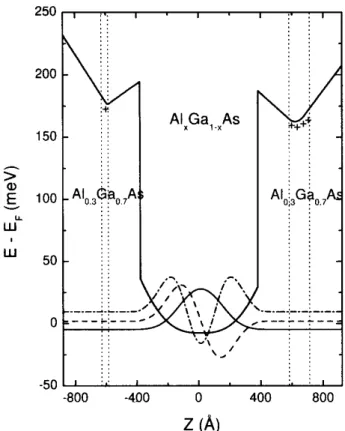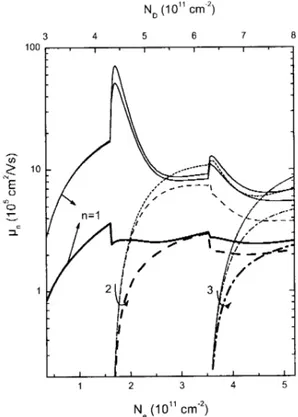Low-Temperature Eletron Mobility in
Paraboli Quantum Wells
R. M. Seraideand G.-Q. Hai
InstitutoFsiade S~aoCarlos, USP,13566-590 S~aoCarlos,SP, Brazil
Reeivedon23April,2001
Wepresent a theoretialstudyonthe eletronmobility and satteringmehanism inaremotely
dopedAlGaAswideparaboliquantumwell. Eletron mobilitiesindierentsubbands are
alu-lated fromtheself-onsistent resultsof thesubbandenergyand wavefuntioninthesystem. The
satteringduetoionizedimpuritiesandalloydisorderisonsidered. Weshowtheinterplayofthe
dierentsatteringmehanisms.
I Introdution
Improvementsofthesemiondutorgrowthtehniques
have oered the possibility to obtain low-dimensional
semiondutorstrutureswithdesiredwellshapes. One
of those strutures is the so-alled paraboli
quan-tum well (PQW). The PQW's based on GaAs have
beendeveloped bytailoring theondution-bandedge
of a graded Al
x Ga
1 x
As semiondutor ternary alloy
throughproperlyvarying theAl molefration x.[1, 2℄
Beause athikand uniformeletronslab(in orderof
10 3
A)anbeobtainedinawidePQW,remotelydoped
widePQW'shavebeenproposedasstruturesinwhih
ahigh-mobilityquasi-three-dimensional(Q3D)eletron
gasanberealized. Magneto-transportexperimentson
thesesystemsonrmedtheexisteneofathikslabof
high-mobilityeletrongas.[2℄
Althoughanumberofexperimentalandtheoretial
studieshavebeendoneontheeletrontransport
prop-erties in suh a system sine the rst AlGaAs PQW
was realizedby MBE twelveyears ago,the sattering
mehanism and eletron mobility are not well
under-stoodyet.[3℄Infat,theso-alledQ3Deletrongasisa
systemomposedbyawideQ2Dsystemwithmultiple
eletronsubbandspopulated.Clearly,theintersubband
interationisofimportantontributiontotheeletron
transport. Furthermore, beyond the remotely doped
impurity sattering, other sattering mehanisms an
bedeisiveto theeletronmobilitysuhasalloy
sat-terngandbakgroundaeptorsin arealsample.
In this work, we study theoretially the eletron
mobilityandsatteringmehanisminAlGaAsPQW's.
We start witha self-onsistentalulation of the
sub-band struture in Se. II whih yields the subband
energyandthewavefuntioninthesystem. Twolayers
of donors are remotely doped asymmetrially in two
sides of the well. Typially more than one subbands
arepopulated. Theionizedimpuritysatteringand
al-loysatteringareonsideredinSe. III.Thetransport
mobiltyofeletronsindierentsubbandsarealulated
bysolvingtheBoltzmannequation. Wealsoonsidered
theeetsofthebakgroundaeptorsontheeletron
mobilities. Weshowtheinterplayofthedierent
sat-teringmehanisms.
II Eletroni strutures
The eletron energy and wavefuntion in a Q2D
sys-tem an be written as E
n (
~
k) = E
n +~
2
k 2
=2m
and
n; ~
k
(x;y;z) =
n
(z)exp(i ~
k~r)= p
A; where n =1, 2,
... is the subband index, ~r ( ~
k) the eletron position
(wavevetor) in the xy-plane, E
n
thesubband energy,
n
(z)theeletronwavefuntioninthez-diretion,m
theeletroneetivemass,andAtheareaofsample.
The paraboli quantum wells are formed by
Al
0:3 Ga
0:7
As barrier and the onentration of the Al
isvariedfromx=0attheenterofthewelltox=0:1
at the edge of the well. By tailoring the
ondution-band edge of Al
x Ga
1 x
As, weonstrut thefollowing
onnementpotentialtotheeletrons
V
C (z)=
1
2 m
2
z 2
; jzjW
QW =2
V
B
; jzj>W
QW =2,
(1)
where V
B
is the potential of the barrier, =
2 p
2V
b =m
=W
QW
,andW
QW
isthewidthofthe
quan-tum well. In the above expression, the potential
at the enter of the QW is zero (GaAs). At the
edges of the well (z = W
QW =2), V
C = V
b: Notie
that V
b V
B
: The ondution band o-set between
Al
x Ga
1 x
As and GaAs is a funtion of x given by
V(x) = 0:6(1:155x+0:037x 2
) eV. In the present
alulation, we take V
B
= 228 meV (x = 0:3) for
systemisremotelydopedwithtwolayersofimpurities
in twosidesof thequantum well. Theimpurity
distri-bution istakenthefollowingform
n
D (z)=
8
<
: N
D;L =W
D;L
; jz Z
D;L jW
D;L =2
N
D;R =W
D;R
; jz Z
D;R j<W
D;R =2
0; otherwise,
whereN
D;L ,W
D;L and Z
D;L (N
D;R ,W
D;R andZ
D;R )
are the arealonentration, thethe thikness and the
positionofthedopedimpuritylayerontheleft(right)
sideofthequantumwell,respetively.
ThesubbandenergyE
n
andtheeletron
wavefun-tion
n
(z) aredeterimed bythe Shrodinger equation
in thez-diretion. The eetiveonnementpotential
entering the Hamiltonian is V
eff
(z)= V
H (z)+V
C (z)
whih is omposed as a sum of the potential V
C (z)
givenin Eq. (1)andtheHartreepotentialV
H
(z). The
Hartree potential, governed by the Poisson equation,
dependesontheionizedimprityandeletron
distribu-tionn
e
(z). Atzero-temperature,theeletron
distribu-tionisgivenby
n
e (z)=
N
X
n=1 j
n (z)j
2 Z
EF
En
(E)dE;
where N is the number of the oupied subbands,
(E) is the eletron density of states of the system
and E
F
is the Fermi energy. Beause the eletron
distribution depends on E
n and
n
(z), the solution
of the Poisson equation is, in turn, dependent on
the Shrodinger equation. In this work, we solve
the oupled Shrodinger and Poisson equations
self-onsistently. Inthealulation,thetotalarealeletron
densityN
e =
R
1
1 n
e
(z)dzis determinedbythe
dier-ene betweenN
D and N
A
, where N
D =N
D;L +N
D;R
is total areal donor onentrations and N
A
is the
to-tal areal aeptor onentrations. N
A
an be
esti-matedfrom thethiknessofthedepletionlayerwitha
uniform distribution of the bakground aeptors n
A .
Fig. 1 gives an example of the self-onsistent
solu-tionsforaquantum wellofwidthW
QW =760
A. The
eetive onnement potential prole V
eff
(z)
(thik-solidurve),therstthreequantizedeletronlevelsE
n
andtheorrespondingwavefuntions
n
(z)are
demon-strated. Inthegure,theenergyismeasuredfromthe
FermienergyE
F
. Twodonorimpuritylayersare200
A
awayfromtherightandleft edgeofthequantumwell
indiatedbythevertiledottedlines. Thebakground
aeptoronentrationistakenasn
A =10
15
m 3
.
Figure1. Theeletroni strutureof a paraboli AlGaAs
quantum well of width 760
A. The donor distribution is
dened by the parameters: ND;L = ND;R = 1:510 12
m 2
,WD;L=20
A,WD;R=100
A,ZD;L= 590
A, and
Z
D;R = 630
A. The aeptoronentration is n
A = 10
15
m 3
. TherstthreelevelsE
n
areindiatedandthe
orre-spondingwavefuntionsaregivenbysolid,dash,and
dash-dottedurves. Thevertial thin-dottedlinesand the
sym-bles\+"indiatethetwodoppinglayers.
III Sattering mehanismand eletron
mobility
Atlow-temperature,themostpossiblesattering
meh-anisms limitting the eletron mobility in the present
systemarethe remotelydopedionized donors,the
al-loydisorderpotentialof AlGaAs,and thebakground
aeptors.[4,5℄
Thesreeningoftheeletrongasisessentialto
de-terminethe sattering due to ionized impurities. The
sreenedionizedimpuritypotentialanbeobtainedin
termsof the stati dieletri response funtion within
the random-phase approximation (RPA). Beause of
theoupationofseveralsubbands,thedieletri
fun-tionhasatensorharatergivenby
nn 0
;mm 0
(~q). Ifwe
assumethattheimpuritiesareuniformlydistributedin
thexy-planeand are unorrelated, the transition
ma-trix element due to the sreened Coulomb sattering
potentialisgivenby,[4℄
jM
nn 0
(~q)j 2
=
2e 2
q
2 Z
dz
i n
imp (z
i )ju
nn 0
(q)j 2
with
u
nn 0
(q)= X
mm 0
1
nn 0
;mm 0
(~q)G
mm 0
(q;z
i );
and
G
mm 0
(q;z
i )=
Z
dz
m (z)
m 0
(z)e qjz zij
;
where ~q = ~
k ~
k 0
is the hange in eletron
momen-tum due to sattering. In equation (2), we take
n
imp
(z) = n
D
(z) for remotely doped donor satteing
andn
imp (z)=n
A
forbakgroundaeptorsattering.
Foralloy sattering, the sattering matrixis given
by[6℄
jM
nn 0
(~q)j 2
=(ÆV) 2
Z
dz[1 x(z)℄x(z)j
n (z)
n 0
(z)j 2
;
wherex(z)isthepositiondependentAl onentration.
ForAlGaAs,ÆV =0:6eV.Notiethat,thematrix
ele-mentduetoalloysatteringisindependenton~q.
Usingtheabovesattering matrixelementsdue to
dierent sattering mehanism, we alulate the
ele-trontransport mobility from the Boltzmann equation
inthepresentmultisubband Q2Dsystem.[4℄
Fig. 2showsthetransport mobilitiesasafuntion
of total eletrondensityfor the eletronsin subbands
n=1,2,and3dueto three dierenttypesof
satter-ing. Thenumerialalulationsare performed forthe
samestrutureasshowninFig. 1butnowweinrease
thedonordensity N
D;L andN
D;R
simultaneously. As
a onsequene, the eletron density is inreased. At
low eletrondensities, themobilityof the eletronsin
thelowestsubbandn=1inreaseswithinreasingthe
eletron (also donor) density. This is mainly due to
thesreeningeets andtheinreaseofthekineti
en-ergyof theondution eletronsonthe Fermi surfae.
Atthe onset ofthe oupationof theseond subband
n = 2, the abrup hange of the mobility results from
the interplay between the intersbband sattering and
theintersubbandoupling eetin thedieletri
fun-tion (whih enhanes the sreening and is more
ee-tiveforsmall subbandFermi energyE
F E
n
). When
therearetwoorthreesubbandsoupied,themobility
derease of the lower subbands is mainly indued by
theintersubbandsattering. Fortheonsidered
bak-ground aeptor onentration n
A = 10
15
m 3
, the
aeptorsattering is thedominantmehanism tothe
eletrontransport. Wealso notiethat thealloy
sat-teringbeomemorepronounedathigheletron
densi-ties.
In onlusion,wehavealulatedtheeletron
sub-bandmobilitiesfromtheself-onsistenteletroni
stru-tureoftheAlGaAswideparaboliquantumwells. The
numerialresultsshowsthat,fortheonsidered
stru-ture with a bakground aeptor onentration n
A =
10 15
m 3
, the mobility is dominated by the
satter-ing of these aeptors. Our results also indiate the
Figure 2. The transportmobility as afuntion ofthe
to-taleletrondensityforeletronsintherstthreesubbands
n =1 (solid urves), 2 (dash urves), and 3 (dash-dotted
urves). Themobilitiesresultfromtheionizeddonor
sat-teringonly(thin-urves),theionizeddonor+alloy
satter-ing, and the ionized donor+ aeptor+ alloy sattering
(thethik-urves)areplotted.
Aknowledgments This work was supported by
FAPESPandCNPq(Brazil).
Referenes
[1℄ E. G.Gwinn, R. M. Westervelt, P. F. Hopkins, A. J.
Rimberg,M.Sundaram,andA.C.Gossard,Phys.Rev.
B39,6260 (1989);T.Sajoto,J.Jo,M.Santos,andM.
Shayegen,Appl.Phys.Lett.55,1430(1989);K.Karrai,
H. D. Drew, H. W. Lee, and Shayegan, Phys.Rev. B
39,1426(1989).
[2℄ A.Wixforth,Surf.Si. 305,194(1994),andreferenes
therein;P.F.Hopkins,A.J.Rimberg,E.G.Gwinn,R.
M.Westervelt,M.Sundaram,andA.C.Gossard,Appl.
Phys.Lett.57,2823 (1990).
[3℄ G. Salis, P.Wirth, T. Heinzel, T. Ihn, K.Ensslin, K.
Maranowski,andA.C.Gossard,Phys.Rev.B59R5304
(1999),andreferenestherein.
[4℄ G.Q.Hai,N.Studart,andF.M.Peeters,Phys.Rev.B
52,8363(1995);G.Q.HaiandN.Studart,Phys.Rev.
B55,6708(1997).
[5℄ G. Q. Hai and N. Studart, Phys. Rev. B 52, R2245
(1995).

